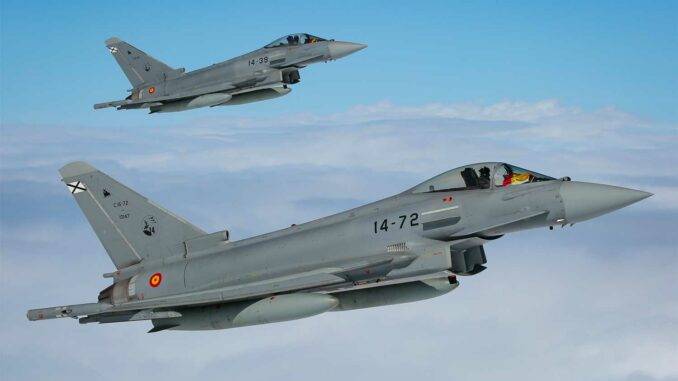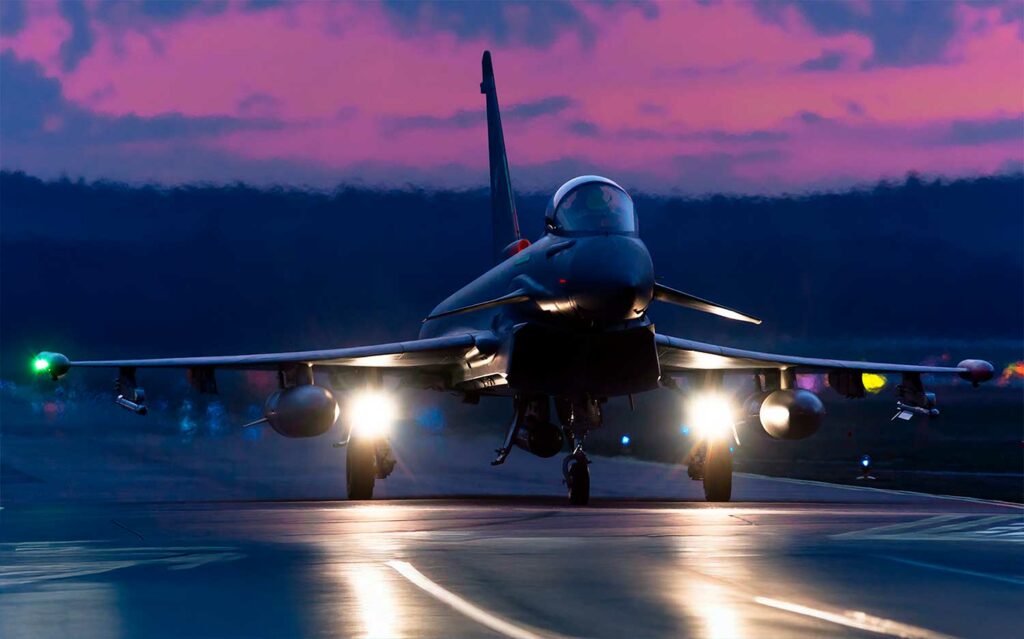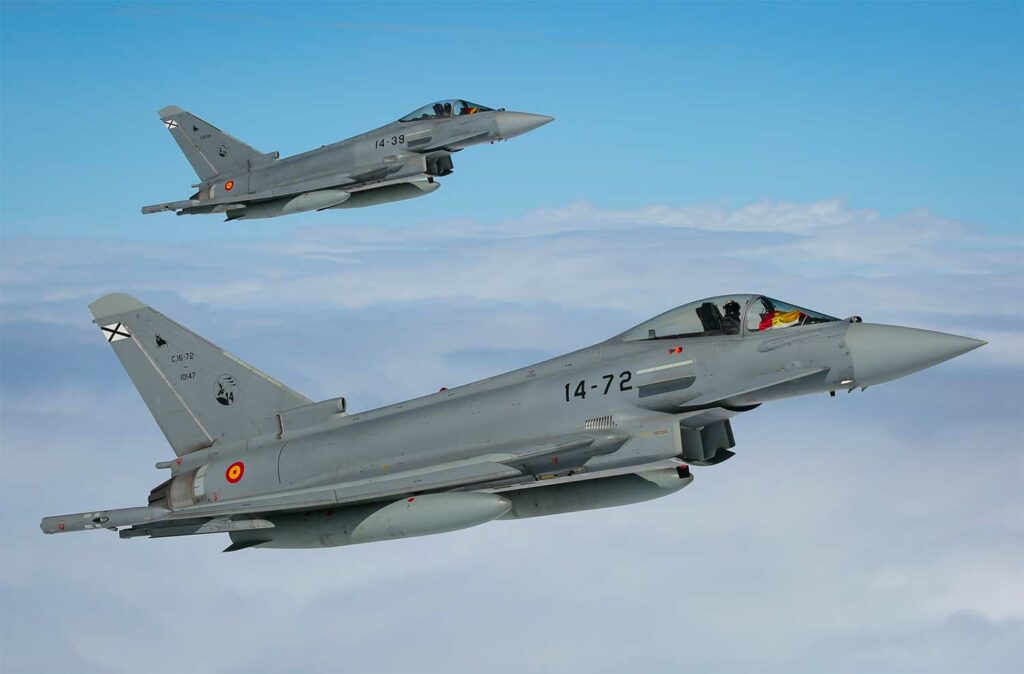
A technical and statistical overview of the future of the Eurofighter Typhoon: its role in the face of 5th/6th generation fighters, its upgrades (AESA radars, weapons), and its industrial challenges.
The state of play for a major European interceptor
The platform and its current performance
The Eurofighter Typhoon is a twin-engine delta-wing aircraft designed for air superiority and swing-role capabilities. Its agile airframe and high thrust-to-weight ratio enable it to reach Mach 2 (2,495 km/h) at altitude, with an operational altitude of 16,764 m (55,000 ft). Its mission architecture, now fully multi-role, carries up to 9,000 kg of weapons on 13 hardpoints.
In terms of air-to-air weapons, the Eurofighter Typhoon’s technology relies on Meteor for long-range engagement, complemented by AMRAAM and ASRAAM/IRIS-T for short range. For air-to-ground missions, the Eurofighter Typhoon’s weapons include Storm Shadow/SCALP, Brimstone 2, Paveway IV and guided bombs. These swing-role capabilities meet NATO requirements for air policing and precision strike.
Positioning against 5th generation aircraft
Compared to 5th generation fighters (F-35/F-22), European air defense with the Eurofighter Typhoon relies less on passive stealth than on kinematics, radar power, NATO interoperability and modernized multi-sensor fusion. A new-generation Typhoon will not be invisible like an F-35, but it compensates with:
- an AESA radar with a wider field of view, useful for “off-boresight firing” and BVR ambush tactics;
- the integration of data links and ramjet missiles (Meteor) that conserve energy at the end of their trajectory;
- a significantly upgraded electronic warfare pod and DASS (self-protection).
The operational effectiveness of the Eurofighter Typhoon is measured on a daily basis in NATO (QRA, Air Policing). On these missions, logistical footprint, availability, and payload capacity remain decisive factors.
Comparison with the Rafale
The comparison between the Eurofighter Typhoon and the Rafale pits two similar but distinct European philosophies against each other. The Rafale F4 emphasizes “omni-role” and highly advanced organic air-to-ground/air-to-air integration, with RBE2 AESA, SPECTRA, and Meteor. The Typhoon, historically an air dominance aircraft, has caught up in the strike segment with Storm Shadow and Brimstone, and aims to overcome its sensor/GE lag through the modernization of the Eurofighter Typhoon fighter aircraft (see below). In high-intensity NATO scenarios, the Rafale–Typhoon duo is complementary; each fleet benefits from cooperation and the exchange of tracks via datalinks.

The modernization of the Eurofighter Typhoon: radars, GE and weapons
The sensor core: ECRS Mk0/Mk1/Mk2 AESA radars
The cornerstone of the Eurofighter Typhoon upgrade is the transition to AESA “ECRS”:
- ECRS Mk0 (Kuwait/Qatar) introduced E-scan on the Typhoon.
- ECRS Mk1 (Germany/Spain) brings a new generation of air-to-air/air-to-ground capabilities, with detection > 200 km and, above all, a field of view of up to ~200° thanks to the repositionable antenna. This design offers a tactical advantage in off-axis pursuit and track maintenance during aggressive maneuvers. The Quadriga (Germany) and Halcón (Spain) series are equipped with this standard.
- ECRS Mk2 (United Kingdom/Italy) adds an active electronic warfare (Electronic Attack) function thanks to a broadband Multi-Function Array: in addition to seeing, it jams, isolates and suppresses ground-to-air threats, paving the way for SEAD/DEAD profiles from Typhoon.
Key points to remember: the Eurofighter Typhoon’s capabilities are advancing significantly in countermeasures, SAR mapping, GMTI and multi-target tracking. The Mk2, coupled with defensive aids, transforms the aircraft into an offensive/defensive RF node. This is the central focus of the future Eurofighter Typhoon modernization program (P4E/LTE).
Electronic warfare: from the current Praetorian to “Praetorian eVolution”
The Praetorian self-protection system (DASS) is evolving into Praetorian eVolution: bandwidth expansion, advanced DRFM, complex threat characterization, interfaces for electronic attack pods. The objective is clear: to remain operational until 2060 against increasingly networked IADS. The military strategy and the Eurofighter Typhoon converge here: survive under an anti-access bubble, degrade the enemy’s fire chain, and create windows of opportunity for stealth fleets.
Armament: Meteor confirmed, SPEAR delayed, air-to-ground arsenal expanded
- Air-to-air: Meteor is operational on several European Typhoon fleets. Its variable thrust propulsion conserves energy beyond the kinematics of a conventional AMRAAM, which is useful against 5th generation fighters seeking kinematic “stalling.”
- Air-to-ground: Storm Shadow/SCALP for long-range penetration, Brimstone 2 for low collateral damage neutralization of fast targets, Paveway IV for close support.
- Collaborative effects: SPEAR 3 (mini-cruise missile) and its variant SPEAR-EW (stand-in jammer) are intended to reinforce SEAD profiles in saturation and swarming. However, schedules are slipping: the United Kingdom is now announcing entry into service in the early 2030s. This is a point of attention for the modernization of air fleets with the Eurofighter Typhoon; the interim solution relies on the ECRS Mk2 + existing effects (Storm Shadow/Brimstone) combination and the use of new-generation jamming UAS.
The German “EK” version: a dedicated SEAD role
Germany is converting 15 Typhoons into Eurofighter EKs (Elektronischer Kampf) to replace Tornado ECRs around 2030: integration of an extended EW suite, use of anti-radar missiles and electronic attack pods. The role of the Eurofighter Typhoon in NATO is thus expanding to include dedicated SEAD/DEAD, while remaining the backbone of air policing.
The place of the Typhoon in the face of 6th generation aircraft (GCAP/FCAS)
The capability bridge to 2035–2040
The GCAP (UK-Italy-Japan) and FCAS/SCAF (France-Germany-Spain) programs aim for entry into service around 2035–2040. They promise multi-spectral stealth, onboard AI, collaborative combat, and swarms of effectors. Until then, the future of the Eurofighter Typhoon fighter jet is that of a bridge:
- maintaining combat mass and availability;
- modernizing the Eurofighter Typhoon fleet via P4E/LTE (radars, GE, cockpit, links, weapons);
- progressive MUM-T integration with escort drones (stand-in jammers, remote sensors).
**Key message: investing in *the modernization of European fighter jets* is useful and cost-effective to bridge the 2025–2035 decade, stabilize the aerospace industry and the Eurofighter Typhoon, and reduce the risks associated with delays in the 6th generation program.
Expected operational gains (and their limitations)
Concrete benefits
- Information superiority: ECRS Mk1/Mk2 increase range, resolution, and resilience to jamming. The ~200° field of view changes BVR tactics (off-axis tracking/scanning without penalizing maneuvers).
- Survivability: Praetorian eVolution and Electronic Attack on the Mk2 enable penetration corridors under IADS.
- Lethality: Meteor stabilizes the air-to-air bubble. Storm Shadow and Brimstone cover deep strike and close support. SPEAR-EW/3, once available, will provide density and modularity.
- NATO interoperability: modernized connectivity and military strategy and the Eurofighter Typhoon are aligned with allied architecture (C2, E-7, UAS swarms).
Points to watch
- Arms schedule: SPEAR 3 delays are weighing on the British Typhoon’s air-to-ground stand-off toolbox.
- Industrial workload: the future of production lines depends on export orders (active discussions in Europe and the Middle East) and national tranches (Quadriga, Halcón).
- Stealth competition: even with improvements, a 4.5G aircraft remains more visible than 5th generation aircraft; it must rely on maneuverability, sensor cooperation, and EA to shape combat.
Industrial and export challenges
Order momentum and the “modernization” effect
The new Quadriga (Germany) and Halcón I/II (Spain, 25 additional aircraft, deliveries 2030–2035) orders secure business until the mid-2030s. The P4E/LTE packages clarify the roadmap, reassure customers and support exports (active proposals, discussions on additional batches in the Middle East and Europe). The aerospace industry and the Eurofighter Typhoon involve 400+ companies and 100,000+ jobs across Europe, a strong argument for sovereignty and resilience.
The export case
For a customer looking for robust, NATO-interoperable air superiority capability with wide-field AESA radar and Meteor missiles, the new-generation Eurofighter Typhoon is credible. Its initial cost can be lower than that of a complete stealth fleet, especially if the immediate need is for air defense and interdiction with a local industrial base. The modernization of the Eurofighter Typhoon is therefore useful for export, particularly if the packages include ECRS Mk1/Mk2, Praetorian eVolution and a clear weapons roadmap.

Should we modernize or switch directly to the 6th generation?
The budgetary question pits modernization against generational leap. Operational facts argue for a mix:
- Significantly modernize the current fleet (ECRS, DASS, links, cockpit) to last 10–15 years with the operational efficiency of the Eurofighter Typhoon at the required level;
- Invest in future programs (GCAP/FCAS) to reintroduce stealth and native collaborative combat;
- Mitigate schedule risks by decoupling certain critical capabilities (SEAD/EA, stand-off) via pods, dedicated UAS and collaborative effects (SPEAR-EW/3), as soon as they become available.
The future of the Eurofighter Typhoon fighter jet lies in this combination: a 4.5G aircraft that gains the information advantage over 5th generation aircraft through superior sensors and GE, while preparing for the 6th generation. For European forces, this dual gamble strengthens deterrence, maintains combat mass, and stabilizes the industrial ecosystem. The challenge now is to stay on track (Mk1/Mk2, P4E, Praetorian eVolution) and secure ammunition (SPEAR) so that the evolution of the Eurofighter Typhoon is reflected in the squadrons, not just on the drawing board.
War Wings Daily is an independant magazine.